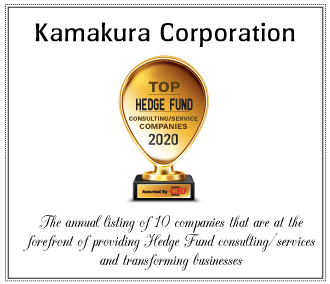THANK YOU FOR SUBSCRIBING
 Eric Penanhoat, Managing Director and Qualitative Risk Specialist
Eric Penanhoat, Managing Director and Qualitative Risk SpecialistIt is indeed an exciting time, and leveraging this trend to establish as a leading market risk system provider for major institutions globally is Kamakura Corporation. Under the guidance of Professor Robert Jarrow, the managing director, research at Kamakura Corporation, the company is uniquely positioned to help innovative investment firms position themselves to cut through the analytical hype. Through its innovative solution set, Kamakura is helping the clients in improving upon the agreed standards of sound quantitative research. “Through our solution, we are, for instance, generalizing and improving Capital Asset Pricing models, Black and Scholes and asset valuations by incorporating additional data, such as probability of default and yield curve modelling, econometric models, statistical techniques, and computing power recently available at scale,” says Eric Penanhoat, managing director and qualitative risk specialist at Kamakura Corporation.
The traditional silos of asset management are shifting and disappearing. Multi-asset class portfolio solutions are needed to meet clients’ needs for financial advice and guidance which include less liquid and private investments. To this end, pension funds and investment management firms are increasingly looking to solve investors need for income generation over long periods. This is the main driver for offering multi-asset class portfolios. Penanhoat states, “Credit risk measures such as probabilities of the default offer a downside risk measure to complement traditional risk and tracking error measures that ignore tail risks across asset classes such as stocks, bonds and derivatives.”
Financial analysts and portfolio managers focus on being less asset-type oriented. For instance, some hedge funds are interested in using credit analysis data such as probabilities of default to complement and refine expected return (alpha) and risk measures. Kamakura’s models and analytics are grounded in sound academic research. It provides the probability of default models, yield curve analytics, valuation models and frameworks that can be combined in a coherent and robust platform. Through its information portal, Kamakura Risk Information Services (KRIS), the company provides simple web access to detail models, data and a set of forecasting tools that seamlessly interface with a cloud-based enterprise cash-flow valuation platform, Kamakura Risk Manager (KRM).
Credit risk measures such as probabilities of default offer a downside risk measure to complement traditional risk and tracking error measures that ignore tail risks across asset classes such as stocks, bonds and derivatives
Kamakura’s models offer a quantitative backbone to address often overlooked and strong assumptions behind most risk and valuation models. Built upon professor Jarrow’s research, the models provide a term structure to realistically represent the finite lifetime of issuers of financial instruments. A state of the art yield curve modeling technology is provided by the company to realistically and adequately apply relevant discount factors for proper valuation as illustrated by the HJM model. This relaxes the common assumptions of Capital Asset Pricing models such as Black and Scholes and bond spread valuation, and also makes sense of AI and machine learning at a time when the financial industry moves beyond the hype. “Kamakura’s long-time expertise in using advanced econometrics is in increasing demand among clients in the investment management sector,” says states Martin M. Zorn, president and chief operating officer of Kamakura Corporation.
What steers Kamakura ahead of the competition is its competent team which comprises of people with extensive experience with some of the most respected banks and investment managers and research institutions in the areas of research, data management and technology. “We offer a unique scope and depth of knowledge of across the set of key functions: research, econometric model implementation, data management, risk systems in some of the most respected financial companies including central banks and banking supervisors on a global basis,” informs Penanhoat. With a research-based analytical solution model and competent team at its helm, Kamakura looks all set to conquer the hedge fund space soon.
|
Share this Article:
Tweet
|

Company
Kamakura Corporation
Headquarters
Honolulu HI
Management
Eric Penanhoat, Managing Director and Qualitative Risk Specialist and Martin M. Zorn, President and Chief Operating Officer
Description
Kamakura’s models offer a quantitative backbone to address often overlooked and strong assumptions behind most risk and valuation models. Built upon professor Jarrow’s research, the models provide a term structure to realistically represent the finite lifetime of issuers of financial instruments. A state of the art yield curve modeling technology is provided by the company to realistically and adequately apply relevant discount factors for proper valuation as illustrated by the HJM model. This relaxes the common assumptions of Capital Asset Pricing models such as Black and Scholes and bond spread valuation, and also makes sense of AI and machine learning at a time when the financial industry moves beyond the hype